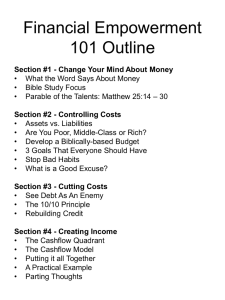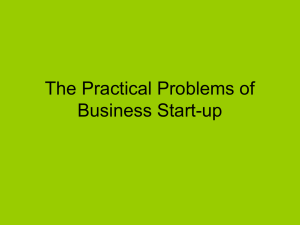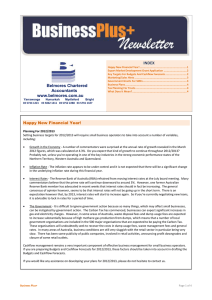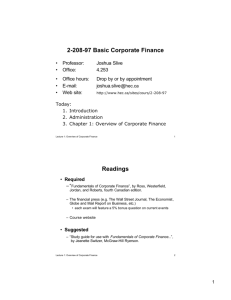Marketing - Newcastle University
advertisement
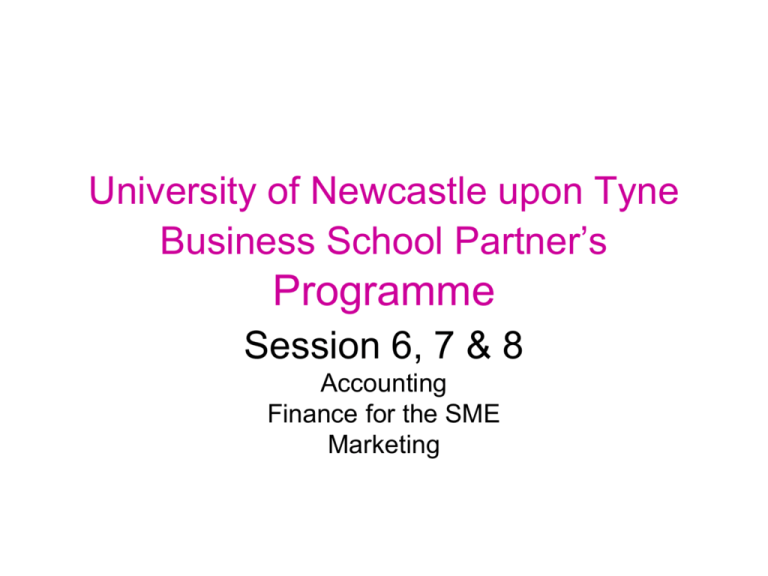
University of Newcastle upon Tyne Business School Partner’s Programme Session 6, 7 & 8 Accounting Finance for the SME Marketing Important Considerations • Cash • Profit • Business Planning Brief Introduction to financial statements • Working in groups of 4-5 discuss what you need to know about a business to judge its financial position? Types of Financial Statements • Profit & Loss Account (P&L) – shows the business income, expenditure and profit for the period (usually one year) • Cashflow statement – a working example of the effects of cash in and cash out • Balance Sheet – this is the company’s statement of assets and liabilities at a specific time (usually at the end of the year) Why prepare a P&L account and a cash flow statement? • Profit is not a measure of cashflow • Businesses fail because they run out of cash • Being in profitiable does not mean you are going to survive as a business • In companies that are not operating in retail (cash business) most sales and purchases are made on credit and recorded when made. • Timing difference between recording the income and expenditure in the accounts and receiving/paying the cash Continued… • Fixed assets (which are?) have to account for depreciation. • The cost is spread over their expected useful life and charged against profit – HOWEVER the cash outflow occurs when the company pays for them and is therefore impacts on the cashflow of the business Continued… • Accountants make many adjustments so that the reported profit figure reflects all the income earned during a period (usually a year) and all the expenditure incurred. • The link between income, expenditure and cashflow in therefore tenuous Cash is King! • Working in your groups discuss why you think the above statement is important? So which is most important cash or profit? • If you run out of cash you will go out of business • If you don’t make a profit you will eventually go out of business • Pricing your product or service is critical and needs careful consideration Business Planning • As you will see by considering the case study company financial planning is paramount to business success • This is normally presented in a business plan format • Forecasts the funding requirements for start-up, predicted sales, cash required • Able to monitor predicted sales to the actual so that the business can make adjustments P&L Account - Key words! • Gross profit – sales less cost of sales • Expenses – other costs of running the business • Depreciation – cost of equipment charged over its useful life • Net profit – profit after all expenses but before tax P & L - Key words continued… • Interest - on borrowings • Tax – corporation tax on profits made • Retained profit - left and ploughed back into the business (shown on balance sheet as capital and reserves Balance Sheet • Based on the principle that capital and reserves = total assets less liabilities – the trick is to get the balance sheet to ‘balance’ • Fixed assets – long lasting ones such as fittings, vehicles, software, hardware are shown at cost and consider depreciation over time • Current assets – short term assets such as debtors and cash • Liabilities – money owed, loans, tax • Capital & reserves = after tax from P& L Cashflow • Cashflow in and out monthly • Includes loans & grants which do not appear in the P&L account • Includes input and output VAT which does not appear in the P&L account • Capital expenditure • Shows opening and closing bank balance Watch out for… • Monthly allocation – rent, rates, electricity, telephone etc which are equal • Monthly allocation of sales and expenditure which are not equal – WHY? Considerations • What is a budget? • Why do we need a budget cashflow separate from income and expenditure? • What a does a balance sheet show you? • Which is more important cash or profit? Finance For The Small to Medium size Enterprise (SME) Raising the Money • • • • • Needs careful Planning Think about the long term How much money? Who to approach? Security you can offer backers? • Know the business plan, financial figures & market place Setting up a small business! • What do you need the finance for? In groups of 4-5 discuss – and be prepared to discuss your answer in class! Raising the Money – where can we expect to find it? • • • • • • • • Personal Investment Friends, family & fools! Bank Private investor Venture capital fund Government & local authorities Other companies Combination of the above Personal Investment • • • • • Money tucked away - Redundancy Second mortgage on home Personal guarantee Tax relief on a loan for a business Remember you have to find the money if things go wrong • Give careful consideration before giving personal guarantees • Take legal advice Friends Fools & Family • • • • Do not enter this lightly More easy to convince your family? Have a family plan if things go wrong Have a strategy ‘if things go wrong’ – are you prepared to move house to a smaller one? • Business is enough pressure without having family ones External investment • Rule of thumb – raise five times as much from an outsider as you are putting in yourself ( absolute maximum) usually match or 1-2-3x • Worst case scenario – nothing! • Personal commitment to the business • Financial commitment is relative to the individual! When should you and your Investor Invest? • Wisest course is to prepare forecasts & business plan • Approach possible sources BEFORE you start your business • BEFORE you need the money • Planning ahead and getting a commitment in advance is crucial!! Banks! • Less than 20% of business start ups get funding from a bank! • Don’t blow the opportunity – be well rehearsed • Use the personal touch – i.e. long standing personal account • Often managers only have discretionary lending limit • Shop around – ask for lending rate! Banks – two sources of funding! 1. Overdraft – short term 2. Loan – longer term Investors • Private Investor • Venture capital (money put up by pension funds, insurance companies, banks, investment trusts, industrial corporations, RDA’s • Mainly for expanding businesses Government, Local Authorities, Charities • • • • • • • • Grant Allowances Cheap loans Prizes Small Firms Loan Guarantee Business Link Princes Trust Other companies What to Expect • • • • • Indifference Lack of interest Disbelief Doubt You have to convince sober business people about your idea – this will not be achieved by over statement or rash predictions • Demonstrate competence and skill Fixed and working capital • The need for finance is known as fixed and working capital • What is the difference? Where can the small business get finance? • Working in two’s list in order of priority where you would go to get money to support your new business idea Any Questions? The case-study: Garbeau • Working in groups of 4-5 and considering your assignment – write down five questions you think will be appropriate to ask Jessica – for the next session on 9 July 9.30 -10.30 pm • Best individual question will receive a free Garbeau shirt of your choice! Marketing Entrepreneurs World • Start with the idea – personal experience • Find the market – rather than careful planning • So – no assessment of market needs – rather investigating of customer reaction Remember! • “Entrepreneurial ventures are more likely to start with incremental adjustments to existing products/services or markets rather than large scale developments” • David Stokes Entrepreneurial Marketing • The product or service idea selected by the new owner of a small business is most likely to be determined by their previous experience • Knowledge of the customer base • Knowledge of the market • No formal market research Entrepreneurial marketing • • • • Innovations – the product or service Identification - the customer Interactive marketing – word of mouth Informal - gathering of information • David Stokes 4 I’s of entrepreneurial marketing Definitions of Marketing Marketing is the management process responsible for identifying, anticipating and satisfying consumer’s requirements profitably. The UK Chartered Institute of Marketing Marketing is a social and managerial process by which individuals and groups obtain what they need and want through creating, offering and exchanging products of value with others Kotler P. (1997) The Evolution of Marketing The production era: • Demand exceeds supply • Quantity is all-important • Maximise output from the factory The sales era: • • • • Demand & supply are in equilibrium The ability to maximise production no longer guarantees success The ability to seek out and sell to customers has become important The idea of finding customers for products is paramount The Marketing Era • Customers are more sophisticated & powerful • More competition • Necessary to understand & satisfy customer needs in detail • The ideas of finding products for customers is paramount HENCE THE MARKETING CONCEPT Aims of Marketing • Break into new specific markets • Increase net profits • To introduce & market new & additional product lines to existing customers • Improve & increase gross profit & contribution • To introduce planning & structure to business development opportunities & improve practical awareness of ‘real’ business situations The Marketing Mix • The marketing mix has been described as one of the key concepts in modern marketing theory. Basically this consists of the ingredients a firm puts together to construct its ‘offering’ for the target audience. Kotler (1997) defines the marketing mix as: ‘the set of tools that the firm uses to pursue its marketing objectives in the target market’ The Marketing Mix (the 4P’s) • Product/service – the tangible & the intangible attempt to satisfy customer needs • Price – the monetary summation of the conditions that give value to the product or service • Promotion – the means by which the firm communicates its message to the market • Place – delivery/distribution, the means by which the product/service reaches the market • Getting the right goods to the right people, in the right place at the right time and at the right price The Marketing Mix (the 7P’s) • • • • • • • Product/service Price Promotion Place Participants Physical Evidence Process The Product • Core product – what the product is! • Augmented product – giving the core product distinctive values which distinguish it from the competition • The total product concept The Price • There are only two fools in every market. One charges too little and the other charges too much! • The marketers job is to ensure that the price selected for a product fulfils the various objectives envisaged by the marketing plan and at the same time meets the needs of the market ‘place’. The Price (factors to consider) • • • • Strategic objectives of the company Competitors price and their strategic objective Customers ability to buy Price in relation to the company’s cost and profit goals • Understanding of the product life-cycle • Recognition of legal requirements and regulations • Structure and size of the company The Price (factors to consider) • • • • • • • • Time to market/market penetration objective Market stabilisation Product differentiation Branding Cash recovery Preventing new entry Loss leader policy Price bundling Place • • • • • Distribution methods Transportation Middlemen/retailers Location/site Delivery frequency Promotion • Promotional activity is the means by which organisations communicate with their markets. • The only fundamental justification for expenditure on promotion is to bring about profit. • The organisation may need to involve a variety of communication activities Promotional Mix Tools available for communicating with the market are collectively known as the promotional mix Personal Methods Direct selling Telephone selling Retail selling Text messaging E-mail Exhibitions Impersonal Methods Advertising Direct mail Publicity/PR Leaflets/brochures Catalogue Sales promotions Sponsorship Internet Promotion • The separate elements are normally used in concert, combining for example advertising and sales promotion in the promotion of fast moving consumer goods (fmcg), or advertising and personal selling in the market of industrial products. • Two-way communication is personal selling. IMPORTANT when selling complex products and services Segmentation & Targeting Market segmentation can be defined as “the subdividing of the total market into groups that represent distinct marketing opportunities and have to be reached with a distinct marketing package” Kotler Benefits of Segmentation • Opportunities can be identified more effectively as a result of better market knowledge • Marketing effort can be made more effective through better targeting • The marketing mix can be tailored to the specific needs of the customer Segmentation • Demographic – age, gender, social grade, family life-cycle • Geographic – location • Psychographics – lifestyle, personality, selfconcept • Behaviouristic – benefits sought, user rate • Geodemographic – lifestyle/location • Biographic – transactional data (e.g.store cards) Some Segmentation Classifications • SKIPPIES – school kids with income and purchasing power • MOBYS – mother, older baby, younger baby • DINKS – double income no kids • DEWKS – dual earners with kids • PUPPIES – poor urban professionals • WOOFS – well off older folks The Customer There are three broad classes of customer: • The final customer (consumer) – uses product/service without adding value • The intermediary customer – adds value and sells on • The internal customer – uses the output on another part of the organisation Marketing is about keeping in touch with your customer and giving them the product or service they want!! Marketing & Resources • Entrepreneurs pursue opportunities without regard to the resources required • Need to consider: – What resources are needed – Where will they come from – How they will be used – How they will be controlled & monitored Small firms need to demonstrate a competitive advantage - USP • Product • Service • • • • • • • Quality Extra benefits Durability Reliability Performance Design Extra service: delivery guarantee, installation customer service Evaluate Competitive Advantage is the differentiation: • A benefit that meets customer’s needs? • Something customers will pay for? • Distinct? • Better than competitors? • Profitable to the business? • Hard to copy? REMEMBER!! • Unless a business has a sound marketing ‘base’, it will have difficulty in growing successfully, because it has to be able to find and meet customer needs. Think about…. The Augmented Product? The Augmented Product Core Product ? The Augmented Product brand service price reputation quality Core accessibility Product image Existing customers Group Work • Working in groups of 2-3 write down the core product of Garbeau and discuss the augmented products. Can you identify the unique selling points of the company? Any Questions?
